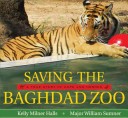 Saving the Baghdad Zoo: A True Story of Hope and Heroes
Saving the Baghdad Zoo: A True Story of Hope and Heroes
Written by Kelly Milner Halls with Major William Sumner
HarperCollins, 2010, 64 pp.
ISBN: 9780061772023
“Things were blowing up all around us. We were fighting a war. But in this one place, at the zoo, we could fix something. We could do something good for the people we were trying to help. Right there in the middle of a war was this beautiful green park with grass and trees and lakes. It was an oasis in a shattered, concrete world” (p. 61).
People are not the only victims of war. Major Sumner served in the US Army 354th Civil Affairs Brigade and went to Baghdad in April 2003 with the stated mission of helping to restore cultural heritage. Asked to look at a small zoo, he discovered it was one of the largest in the Middle East and, along with three palace zoos and other animal collections, contained valuable animals with no food and water. Amidst fighting and looting, people from many countries worked in a cooperative way to save the animals and eventually restore the zoo. Through photographs and well created non-fiction text, the story of the challenges faced by these determined individuals with a love for animals will touch the hearts of all. The soldiers of the 3rd Infantry Division initially took responsibility to care for the animals—those not stolen for black market sale or used for food since most animals had escaped military fire. With help from the Iraqi zoo staff, who also were given care and support for their families, other organizations eventually entered the scene, providing support through food, medical supplies, and other professional assistance. Because of the efforts of many, the Baghdad Zoo now stands as a cultural oasis of hope amidst conflict.
Divided into chapters according to some of the most interesting rescue stories, readers meet Lumpy, the camel who was transported during sniper fire; Saedia and Samir, bears with distinctive medical needs; Brutus, a new lion father; Mandor, a respected Bengal tiger who was joined later by companions from the U.S.; horses, the unique symbol of the Arabic culture; and other smaller animals such as pelicans and dogs. Each animal offers lessons in animal care, special needs, characteristics and personality, potential danger when not cared for properly, and significance to the Iraqi culture. Adding to the authenticity of the events as told by participants in the efforts to save the zoo are side bars with facts about the various animals and their lifestyles, information about the region itself, and a brief explanation of the war. Learning about the animals that are valued by Iraq teaches much about culture and portrays the joy that the zoo and animals bring to the people, creating a connection with people in other countries. The stories are filled with emotional events for the soldiers and specialists in animal care. As readers share these stories relayed by participants to the author, including a letter from Major Sumner to readers, they experience greater insight into the effects of war for a community as well as greater appreciation for the work to sustain a zoo in any country.
Of importance also is the focus on the collaboration between American military and Iraqi people as Major Sumner emphasizes the need to give the Iraqis the lead role and ownership in their zoo whenever possible, relating the cultural efforts to support and not control by the soldiers. As the reader comes to know the key players in saving the zoo, they will be interested in an end page that describes where each person is now and, in some cases, gives a website to follow up on his/her work. “The future is uncertain in many Iraqi communities. Battles are begin fought. But inside the giant gates of the Baghdad Zoo, hope endures” (p. 58).
The rescue of animals in other countries in situations that call for a global response is often a way that children can realize similarities in their lives and those of people in other countries who care about animals. Other titles with this focus include Owen & Mzee: The True Story of a Remarkable Friendship (Isabella and Craig Hatkoff and Dr. Paula Kahumbu, 2006). This title, along with the two other books about Owen & Mzee, describe an animal rescue following the Tsunami in December 2004. Nubs: The True Story of a Mutt, a Marine & a Miracle (Brian Dennis, 2009) relates yet another tale of animal rescue during the recent Mid-eastern conflict. Knut, How One Little Polar Bear Captivated the World (Craig, Julianna, Isabella Hatkof and Dr. Gerald Uhlich, 2007) tells how the Berlin zoo cared for a baby polar bear.
Janelle B. Mathis, University of North Texas, Denton, TX
WOW Review, Volume II, Issue 4 by Worlds of Words is licensed under a Creative Commons Attribution-NonCommercial-ShareAlike 4.0 International License. Based on work at https://wowlit.org/on-line-publications/review/ii-4/

I like this story so much Nasreen’s.